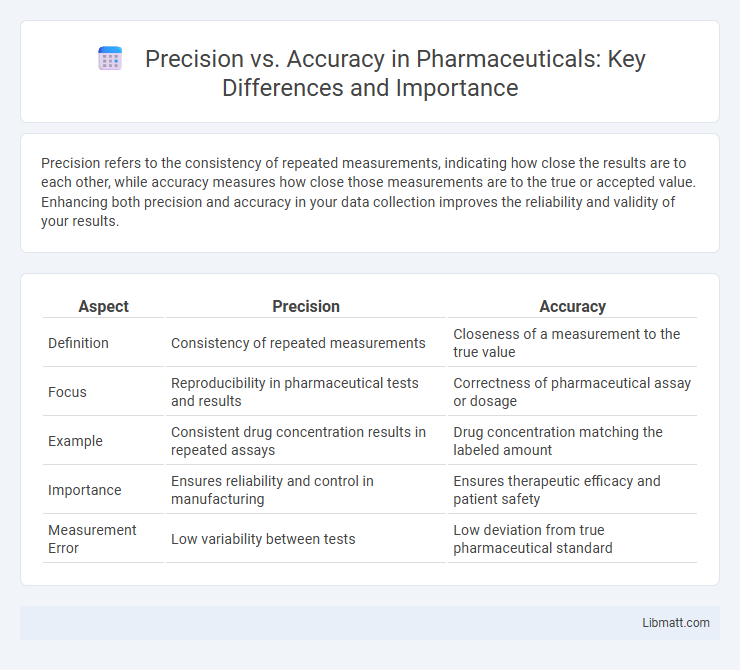Precision refers to the consistency of repeated measurements, indicating how close the results are to each other, while accuracy measures how close those measurements are to the true or accepted value. Enhancing both precision and accuracy in your data collection improves the reliability and validity of your results.
Table of Comparison
| Aspect | Precision | Accuracy |
|---|---|---|
| Definition | Consistency of repeated measurements | Closeness of a measurement to the true value |
| Focus | Reproducibility in pharmaceutical tests and results | Correctness of pharmaceutical assay or dosage |
| Example | Consistent drug concentration results in repeated assays | Drug concentration matching the labeled amount |
| Importance | Ensures reliability and control in manufacturing | Ensures therapeutic efficacy and patient safety |
| Measurement Error | Low variability between tests | Low deviation from true pharmaceutical standard |
Understanding Precision and Accuracy
Precision refers to the consistency of repeated measurements, indicating how close the results are to each other, while accuracy reflects how close a measurement is to the true or accepted value. Understanding precision and accuracy is crucial in fields like scientific research, engineering, and quality control to ensure data reliability and validity. Your ability to distinguish between these concepts enhances the interpretation of experimental results and decision-making processes.
Key Differences Between Precision and Accuracy
Precision refers to the consistency of repeated measurements, indicating how close the values are to each other, while accuracy measures how close a measurement is to the true or accepted value. Key differences include that precision emphasizes reproducibility without necessarily hitting the target, whereas accuracy focuses on correctness, regardless of variability. Understanding these distinctions is crucial for your data analysis and quality control processes to ensure reliable and valid results.
Real-World Examples of Precision vs Accuracy
In manufacturing, precision refers to consistently producing parts within tight measurement tolerances, while accuracy ensures those parts meet the desired specifications. For example, a CNC machine can produce components with high precision but low accuracy if the calibration is off, resulting in parts that are uniform but not within acceptable dimensions. Understanding the distinction between precision and accuracy helps you improve quality control processes by targeting the specific type of measurement error.
Importance in Scientific Measurements
Precision and accuracy are crucial in scientific measurements because precision reflects the consistency of repeated measurements, while accuracy indicates how close those measurements are to the true value. High precision ensures reproducibility of experiments, enabling scientists to trust their data, while high accuracy guarantees the validity of conclusions drawn from those results. Your scientific findings rely on both factors to maintain reliability and credibility in research outcomes.
Applications in Engineering and Technology
In engineering and technology, precision refers to the consistency of repeated measurements or processes, while accuracy indicates how close those measurements are to the true or desired value. Applying high precision is crucial in manufacturing for quality control and reducing variability, whereas high accuracy ensures the reliability and functionality of engineering designs and systems. You can achieve optimal performance by balancing both precision and accuracy in calibration, testing, and instrumentation.
Common Misconceptions About Precision and Accuracy
Precision and accuracy are often mistakenly used interchangeably, but they represent different concepts: precision refers to the consistency of repeated measurements, while accuracy indicates how close a measurement is to the true value. A common misconception is believing that high precision guarantees accuracy, whereas data can be precise yet far from the correct value due to systematic errors. Understanding this distinction helps you correctly interpret results and improve measurement reliability in scientific and technical contexts.
How to Improve Precision in Data Collection
Improving precision in data collection involves minimizing variability and ensuring consistent measurement techniques across all trials. Utilizing calibrated instruments, standardized protocols, and repeated measurements enhances the reliability of your data. Implementing rigorous training for data collectors also reduces human error and boosts the consistency of results.
Methods to Enhance Accuracy in Experiments
Improving accuracy in experiments relies on calibration of measurement instruments against known standards and implementing rigorous control of experimental variables. Utilizing high-quality, precise equipment reduces systematic errors, while repeated trials and statistical analysis help identify and correct biases. Documenting protocols thoroughly ensures consistency, enabling replication and validation of results to enhance overall experimental accuracy.
Precision vs Accuracy in Quality Control
Precision in quality control refers to the consistency of repeated measurements or production outputs, ensuring minimal variation under the same conditions, while accuracy indicates how close these measurements or outputs are to the true or desired standard. High precision without accuracy can result in consistent errors, whereas high accuracy with low precision causes scattered results around the target value. Balancing precision and accuracy is essential for effective quality control to maintain product reliability and meet regulatory standards.
Choosing the Right Approach: Precision or Accuracy
Choosing between precision and accuracy depends on the specific requirements of the task or measurement. Precision matters most in processes where consistency and repeatability are critical, such as manufacturing calibration or scientific experiments. Accuracy is prioritized when the goal is to obtain results closest to the true value, essential in applications like medical diagnostics or navigation systems.
Precision vs accuracy Infographic

 libmatt.com
libmatt.com